Als wir 2016 begannen, Google AMP zu nutzen, schien es die Zukunft des mobilen Webs zu sein. Doch im Laufe der Jahre haben wir Hunderten von Website-Besitzern geholfen, AMP aufgrund seiner Einschränkungen und Googles veränderter Haltung zum Mobile-First-Indexing zu verlassen.
Like many WordPress users, you might be wondering whether it’s time to deactivate AMP on your Website. Da Google AMP nicht mehr für Top-Suchpositionen erfordert und der Anstieg der wichtigsten Webvitalien, werden wir regelmäßig von unseren Besuchern gefragt, ob AMP entfernt werden sollte.
Wir haben mehrere Methoden getestet, um AMP in verschiedenen WordPress-Konfigurationen zu deaktivieren. Wir stellen Ihnen die zuverlässigsten Methoden vor, die weder Ihrer SEO noch Ihrer mobilen Leistung schaden.
Egal, ob Sie das offizielle AMP Plugin oder ein Theme mit integrierter AMP-Unterstützung verwenden, wir zeigen Ihnen genau, wie Sie den Übergang reibungslos gestalten können.
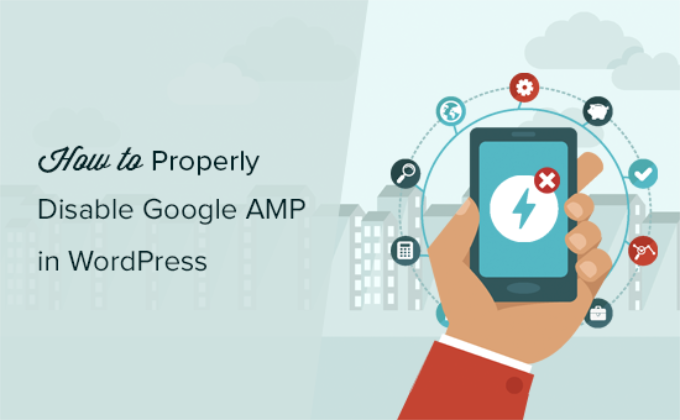
Warum Sie Google AMP in WordPress deaktivieren sollten
Accelerated Mobile Pages (AMP) ist eine Open-Source-Initiative, die das Internet für mobile Nutzer schneller machen und die Benutzerfreundlichkeit verbessern soll.
Dies geschieht durch die Bereitstellung von Seiten mit minimalem HTML- und JavaScript-Code. Dadurch kann der Inhalt im Google AMP-Cache gehostet werden. Google kann dann diese im Cache gespeicherte Version den Nutzern sofort bereitstellen, wenn sie in den Suchergebnissen auf Ihren Link klicken.
Wenn Sie sich jedoch für die Einrichtung von Google AMP in WordPress entschieden haben, könnten Sie das Gefühl haben, die falsche Wahl getroffen zu haben.
Sie sind nicht allein. Viele Blogger, Influencer und Online-Publikationen haben die Verwendung von AMP auf ihren WordPress-Websites eingestellt.
Zunächst werden wir erläutern, warum Sie AMP auf Ihrer WordPress-Website deaktivieren sollten, und dann werden wir Sie durch den Prozess führen.
Google Analytics 4 unterstützt AMP nicht
Google Analytics 4 oder GA4 ist die neueste Version von Google Analytics, die Ihre Website und Ihre mobilen Apps im selben Konto verfolgt. Sie bringt viele Änderungen mit sich, darunter neue Tracking-Methoden, Berichtsfunktionen, Metriken und Berichte.
Zu diesen Änderungen gehört, dass GA4 AMP derzeit nicht offiziell unterstützt, und es ist nicht bestätigt, ob es in Zukunft funktionieren wird. Einer der Gründe dafür ist, dass es Ihre Website und App-Besucher in der gleichen Eigenschaft verfolgt.
Google hat jedoch mitgeteilt, dass Sie nur bis zum 1. Juli 2024 auf alte Daten in der Universal Analytics-Eigenschaft zugreifen können. Das bedeutet, dass Sie immer noch auf Universal Analytics-Berichte zugreifen können, um frühere Daten anzuzeigen, aber Sie können sie in der neuesten Version noch nicht verfolgen.
Drastischer Rückgang der Konversionsraten
Google AMP legt viele Beschränkungen für HTML/JavaScript fest. Das bedeutet, dass viele interaktive Elemente Ihrer WordPress-Website mit AMP verloren gehen, wie Optin-Formulare und Exit-Intent-Popups.
Infolgedessen können Website-Besitzer die Nutzer nicht dazu ermutigen, sich anzumelden, Kontaktformulare auszufüllen oder etwas zu kaufen.
Weniger Seitenaufrufe durch mobile Nutzer
AMP zeigt die Seitenleisten Ihrer Website oder andere Funktionen zum Auffinden von Inhalten nicht an. Dies führt zu einem erheblichen Rückgang der Seitenaufrufe durch mobile Nutzer.
Einige Nutzererfahrungsexperten sind sogar der Meinung, dass die Schaltfläche “Schließen” oben die Nutzer dazu ermutigt, nach dem Lesen Ihres Artikels zur Google-Suche zurückzukehren, anstatt Ihre Website zu durchsuchen.

Geringeres Engagement der Nutzer
Viele Websites leben von der Interaktion mit den Nutzern, z. B. durch Click-to-Tweet-Widgets, Nutzerbewertungen, Kommentare und so weiter. Google AMP macht es Website-Besitzern ziemlich schwer, Nutzer zu binden und mit ihren Inhalten zu interagieren.
Sollten Sie Google AMP deaktivieren?
Die Antwort auf diese Frage hängt tatsächlich von Ihrer Website ab. Wenn mobile Nutzer den Großteil Ihres Publikums ausmachen, dann sollten Sie AMP trotzdem verwenden.
Wenn Sie hingegen Google AMP ausprobiert haben und es sich negativ auf Ihre Konversionsraten ausgewirkt hat, sollten Sie Google AMP auf Ihrer Website wahrscheinlich deaktivieren.
Entgegen der landläufigen Meinung bestraft Google keine Websites, die AMP nicht verwenden. Sie können die Geschwindigkeit und die Leistung Ihrer Website auf dem Handy immer noch verbessern, um für ein mobiles Suchpublikum konkurrenzfähig zu sein.
Mit all dem im Hinterkopf, lassen Sie uns sehen, wie Sie AMP auf Ihrer WordPress-Website deaktivieren können.
Deaktivieren von Google AMP-Plugins in WordPress
Nicht jeder verwendet die gleichen WordPress-Plugins, um AMP-Unterstützung zu seinen Websites hinzuzufügen. Die Grundeinstellungen bleiben jedoch gleich, unabhängig davon, welches Plugin Sie verwenden.
Als erstes müssen Sie das AMP-Plugin, das Sie installiert haben, deaktivieren.
Rufen Sie einfach die Seite Plugins ” Installierte Plugins in Ihrem WordPress-Dashboard auf und klicken Sie auf “Deaktivieren” unter dem Namen des AMP-Plugins.
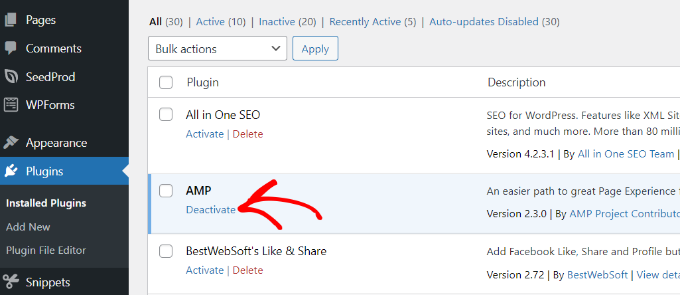
Die Deaktivierung des Plugins reicht aus, um die AMP-Unterstützung auf Ihrer Website zu deaktivieren. Es gibt jedoch noch ein paar weitere Schritte, die Sie befolgen müssen, um sicherzustellen, dass Ihre Website AMP-frei ist.
Einrichten von Umleitungen für AMP-Seiten
Wenn Sie das AMP-Plugin deaktivieren, wird die AMP-Version Ihrer Artikel von der Website entfernt. Das allein reicht jedoch nicht aus, insbesondere wenn Sie AMP länger als eine Woche aktiviert haben.
Die Wahrscheinlichkeit ist groß, dass Google diese Seiten bereits indiziert hat und sie weiterhin in den Suchergebnissen anzeigt. Wenn ein Nutzer auf eine Seite klickt und Sie diese von Ihrer Website entfernt haben, wird er eine 404-Seite finden, da dieser Inhalt nun fehlt.
Um dieses Problem zu beheben, müssen Sie die Nutzer, die auf AMP-Seiten kommen, auf die regulären Nicht-AMP-Seiten umleiten.
Wir zeigen Ihnen zwei verschiedene Methoden zum Einrichten von Weiterleitungen für Google AMP, zunächst mit einem Plugin und dann mit Code. Sie können die Methode wählen, die für Sie am bequemsten ist.
Methode 1: Verwendung eines Redirect-Plugins
Der einfachste Weg, eine Weiterleitung in WordPress einzurichten, ist die Verwendung des All in One SEO (AIOSEO) Plugins. Es ist das beste SEO Plugin für WordPress, das einen leistungsstarken Umleitungsmanager bietet.
Beachten Sie, dass Sie die AIOSEO Pro-Lizenz benötigen, da diese den Redirection Manager enthält.
Zunächst müssen Sie das All in One SEO (AIOSEO) Plugin installieren und aktivieren. Weitere Einzelheiten finden Sie in unserer Schritt-für-Schritt-Anleitung für die Installation eines WordPress-Plugins.
Nach der Aktivierung können Sie im WordPress-Dashboard zu All in One SEO ” Redirects gehen und auf die Schaltfläche “Activate Redirects” klicken.
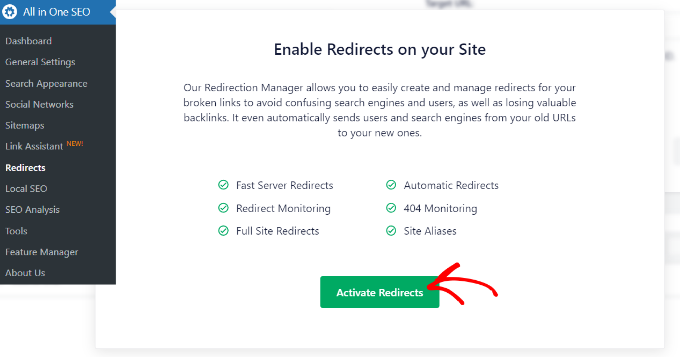
Dies hilft Ihnen dann bei der Installation des AIOSEO Redirection Manager Add-ons, das diese Funktion verwaltet. Nach der Aktivierung werden Sie zur Registerkarte “Umleitungen” weitergeleitet. Hier können Sie die Quell- und Ziel-URLs eingeben, um die Weiterleitung einzurichten.
Klicken Sie zunächst auf das Zahnrad-Symbol im Feld “Quell-URL” und aktivieren Sie dann das Kontrollkästchen “Regex”.
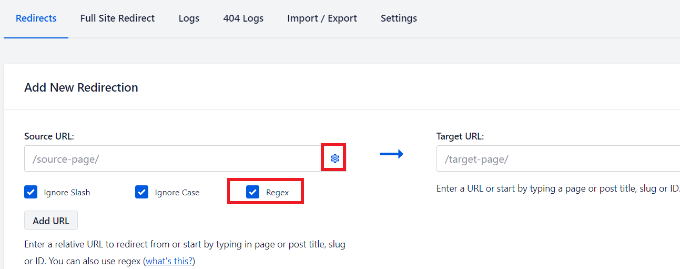
Danach können Sie den folgenden Code in das Feld Quell-URL einfügen:
1 | ^/(.*)\/amp |
In das Feld Ziel-URL müssen Sie die URL Ihrer Website im folgenden Format eingeben:
1 | https://example.com/$1 |
Vergessen Sie nicht, “example.com” durch Ihren eigenen Domänennamen zu ersetzen.
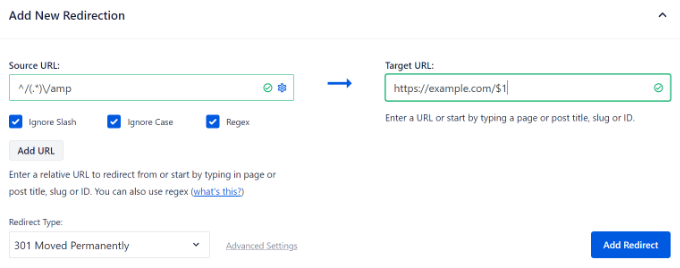
Als Nächstes können Sie den “Umleitungstyp” auf 301 Moved Permanently setzen. Auf diese Weise werden Ihre Nutzer dauerhaft auf die Nicht-AMP-Seiten umgeleitet.
Klicken Sie abschließend auf die Schaltfläche “Umleitung hinzufügen”, um Ihre Änderungen zu speichern.
Sie können nun die URL einer früheren AMP-Seite auf Ihrer Website aufrufen, um zu sehen, ob die Umleitung ordnungsgemäß funktioniert.
AIOSEO hilft Ihnen auch dabei, fehlerhafte Links auf Ihrer Website aufzuspüren. Sie können AMP-Seiten, die zu 404-Fehlern führen, schnell identifizieren und sie umleiten. Weitere Details finden Sie in unserem Leitfaden zur Verfolgung von 404-Seiten und deren Umleitung in WordPress.
Methode 2: Manuelles Festlegen von Umleitungen in .htaccess
Wenn Sie kein Plugin zum Einrichten von Weiterleitungen verwenden möchten, können Sie die Weiterleitung mithilfe der .htaccess-Datei in Ihrem WordPress-Hosting-Konto konfigurieren.
Zunächst müssen Sie sich mit einem FTP-Client oder dem Dateimanager im cPanel mit Ihrer Website verbinden. Weitere Einzelheiten finden Sie in unserer Anleitung zum Hochladen von Dateien in WordPress mit FTP.
Sobald die Verbindung hergestellt ist, müssen Sie die .htaccess-Datei im Stammverzeichnis Ihrer Website suchen.

Als nächstes können Sie die Datei in Ihrem Stammordner bearbeiten.
Fügen Sie dann einfach den folgenden Code am Ende Ihrer .htaccess-Datei ein:
1 2 3 4 | // Redirect AMP to non-AMPRewriteEngine OnRewriteCond %{REQUEST_URI} (.+)/amp(.*)$RewriteRule ^ %1/ [R=301,L] |
Vergessen Sie nicht, Ihre Änderungen zu speichern und die Datei wieder auf Ihren Server hochzuladen.
Sie können jetzt die URL für die frühere AMP-Version eines beliebigen Beitrags auf Ihrer Website aufrufen, um sicherzustellen, dass die Umleitung wie vorgesehen funktioniert.
Wir hoffen, dass dieser Artikel Ihnen geholfen hat, Google AMP in WordPress richtig zu deaktivieren. Vielleicht interessieren Sie sich auch für unsere Schritt-für-Schritt-Anleitung für WordPress-SEO für Anfänger und die besten Tipps zur Beschleunigung von WordPress.
Wenn Ihnen dieser Artikel gefallen hat, dann abonnieren Sie bitte unseren YouTube-Kanal für WordPress-Videotutorials. Sie können uns auch auf Twitter und Facebook finden.





Adeel Qadir
Thanks for such a nice article and your way of explaining was very simple. With this helpful article, I have easily redirected my website and remove AMP successfully.
Lots of thanks
WPBeginner Support
You’re welcome, glad our guide was helpful
Admin
Parkashjit Singh
Hi Sir, i following all the steps but, i saw all the amp link on google which are ranked now how i can removed that amp ranked links on google. As well when i search on google about my site then i saw amp logo after my site tittle even now I’m not using apm. Now how i removed that icon.
WPBeginner Support
You would need to have Google recrawl your site to start removing the content from Google’s search results.
Admin
Parkashjit Singh
How, is there any tutorial or bog. Please send me
WPBeginner Support
You can find our article on how to do this below:
https://www.wpbeginner.com/wp-tutorials/how-to-ask-google-to-recrawl-urls-of-your-wordpress-site/
Raj Deep
My site uses ssl and is on https. Should I use https or http in the redirection ?
WPBeginner Support
Use HTTPS
Admin
Robin
Hey I have page which have /?amp AMP format. So what change I have to do for proper redirection,
As the code given above /(.*)\/amp is only redirection pages with /amp.
Please tell me what change required for this ? thing.
WPBeginner Support
You could create an additional redirect where you add * before amp if you customized your amp URLs to show like that.
Admin
Bob Morris
Thanks. I found this article after one too many posts with 17 indecipherable AMP errors
WPBeginner Support
Glad our guide could be helpful
Admin
Farblos Kay
This is the best website to learn and fix anything WordPress. You guys are geniuses!
WPBeginner Support
Thank you, glad you find our content helpful
Admin
Subodh Gupta
I have disabled AMP on my site using the mentioned codes. But the post/page previews are showing in AMP mode. What to do? Using TagDiv NewsPaper theme.
WPBeginner Support
You would want to ensure you’ve cleared all of your caching for the most common reason for that.
Admin
Adnan
Yours AMP pages are in Google cache, so when Google Bot re-index and check no rel=”amphtml” tag they index non-AMP page.
Julia
Hi, this article sounds very useful, thanks for sharing!
Before I will deactivate/uninstall AMP plugin as well, I have to ask a question.
I have, by mistake, redirected few of amp links (with amp plugin already installed) to my normal url link:
example.com/amp to example.com
The reason why I did that redirect with redirection plugin, is that I had no knowledge of what amp is, and so I thought it’s an error, when I was migrating my site.
Now my question is, should I rather disable all my redirects with amp and then disable/uninstall the AMP plugin and then do the bulk redirect ?
Thank you for your help!
WPBeginner Support
To be safe you may want to create an export of your current redirects, remove them, then do the method in this article to prevent the possibility of multiple redirects
Admin
Pratik Bhatt
Hi,
Can you tell me, when we can remove the redirection plugin. Does google remove the amp pages automatically after some time?
WPBeginner Support
Once the amp pages are no longer being indexed you can remove the redirection. It takes time and Google recrawling your site for the links to be removed.
Admin
Pratik Bhatt
Thanks for the quicky reply.
One more question, I’ve to ask, If I don’t do the redirection, then still google remove the amp pages after some time?
Thanks.
WPBeginner Support
Eventually yes
sam
Hi
I followed the steps above. However, when searching on my mobile device the amp pages are still popping up (It’s only been a few hours so this may be why). When I search on desktop device and type in domain.com/amp the redirect works perfectly. Do you know why this is happening?
WPBeginner Support
You would need to clear any caching as the most common reason it would still be showing up.
Admin
Kuldeep Singh
Worked like a charm.
Thanks!
WPBeginner Support
Glad our guide was helpful
Admin
Jason
Great Guide! Worked like a charm.
WPBeginner Support
Thank you, glad our guide was helpful
Admin
ahs shaikh
thank you very much for this blog post…
WPBeginner Support
You’re welcome
Admin
Rahul sarawagi
Hey,
I tried this way and now my website is not loading, it is giving an error message that
” redirected you too many times ”
Please help me out in getting it back.
WPBeginner Support
For the too many redirects error, you would want to take a look at our guide here: https://www.wpbeginner.com/wp-tutorials/how-to-fix-error-too-many-redirects-issue-in-wordpress/
Admin
Dietrich
I have done method 1 and cleared/deleted cache and it still shows the AMP version? Any tips how to fix?
WPBeginner Support
You would want to check that your host does not have caching enabled and your redirects do no have any typos
Admin
Rohit verma
i have done the first method but it still shows amp version what to do?
WPBeginner Support
You would want to clear any caching as the most likely cause
Admin
Subham
Hi,
You guys are doing great.
After creating AMP i have seen down in my traffic.
So i decided to remove that and i did.
I got many errors. So, i had to install amp again.
Now finally this article helped me a lot to completely remove amp.
Thank you very much WPbeginner.
You are a lifesaver!
WPBeginner Support
Glad our guide could be helpful
Admin
Catherine Thomas
THANK YOU!!!! Method #1 worked perfectly!!!
WPBeginner Support
Glad our recommendations could help
Admin
Akash Gogoi
Can I disable redirection plugin after AMP completely gone from Google search result? Please help.
WPBeginner Support
If you would like you can. Be warned that would remove the redirects so if the links start appearing as broken links in your search console you may need to readd the redirects.
Admin
Enes
Hey. Thank you very much for the info but i had a question. It does not work with me method 1. it suppose to be non amp as soon as i do redirect right ?
my website is https so i made it as https that what it should be ? Thanks in advance
WPBeginner Support
If you are using https then you would want the second field as https, as long as you don’t have caching then it should automatically update. If not, you would want to reach out to the plugin’s support for them to take a look.
Admin
Suanlian Tangpua
When should I remove the redirection?
WPBeginner Support
As it would depend on if Google still links to your AMP pages, we don’t have a set time to remove it we would recommend at the moment.
Admin
Hiral
Hi, thanks for helping. I used method 1. All the blog posts are being displayed in proper format but home page, about, contact such pages are still being displayed in AMP. How to fix it?
WPBeginner Support
You may want to check with the author of the redirection plugin to ensure there isn’t a hiccup with the created redirect.
Admin
Elsaid
Thanks a lot
Now I disable and delete AMP Plugin. and redirect lINKS by first method.
but I have a question , If I want reinstall AMP plugin again
what I should do about redirections????
WPBeginner Support
You would need to remove the redirections.
Admin
Kumarpal Shah
I’ve used Method 1 – Using Redirection Plugin. Now, my question is after adding the redirection is it necessary to keep plugin installed & activated?
OR I can remove the plugin after adding the redirection?
WPBeginner Support
Using the plugin, you would need to keep the plugin active for the redirects to continue.
Admin
Mario
It worked for me wpbeginner thanks a lot
Amp is not advisable use
WPBeginner Support
Glad our article could help
Admin
foodstyling
Hi,
I used the redirection method and the AMP pages are redirected to fine, but the address remain as /?amp.
Should I worry?
WPBeginner Support
If the redirection is working correctly, then you do not need to worry about the urls.
Admin
Mark Llego
I would like to know how can I 301 redirect if my amp url is structured like this
site.com/amp/your-article/
I am using better amp.
Thank you.
WPBeginner Support
Hi Mark,
The htaccess method in this post should handle that redirect for you
Admin
Joanna
Thank you so much! I was struggling with accidentally adding AMP pages and then removing them to losing a lot of traffic. Then, I felt defeated, so I reinstalled AMP. Method 1 with the Redirection plug-in was so easy I wish I had seen this sooner. THANKS!!
WPBeginner Support
Glad our article could help
Admin
Rajesh Ranjan
hii, i followed each and every step but its not working on my WordPress website.
WPBeginner Support
If you removed AMP completely and clearing your cache did not remove the AMP versions you may want to check with your hosting provider to ensure they don’t have caching or similar that would be affecting the AMP pages.
Admin
Margaret
I’m using the Yoast plugin for redirects – what do I input and where to redirect my amp urls to my non-amp ones?
Manh Nguyen
I do as instructed, how long does my site return to normal ?
Thanks!
katie larking
Hi I disabled the AMP plugin and set up a redirect as per the article. The redirect works, but the AMP pages are still in google index and working. How long until google replaces them with my non amp pages. Please let me know how long it takes organically vs anything I can do to speed this up that is proven to work. Thankyou!
Aaron Hunter
This helped so much thank you! I’ve asked WP support, and they had nothing to offer me for a solution. The new version of WordPress.com doesn’t let you deactivate AMP so I used the Redirection plugin. Thank you again!!!
Keith Whitworth
You are an absolute lifesaver! After implementing AMP, my user engagement dropped significantly, my site links in Google totally disappeared, my ranking (for my niche) was at the bottom of the barrel.
AMP is not really designed for podcasts AT ALL.
Once I decided it wasn’t going to work out, I deleted the plugin only to generate thousands of 404 errors related to AMP. I found myself creating unnecessary laborious work creating redirects every day as they popped up.
Finally, I got frustrated and performed a search and replace in my database to remove amp/ which was a massive mistake. Suddenly my site was no longer available. I deleted the plugin and everything was restored but what to do about all the 404 errors related to AMP?
I ran across your website through a Google search and presto. In one fell swoop, all my headaches disappeared. My sitelinks have been restored and yesterday I received an email from Google stating that mobile-first indexing was enabled on my site.
I cannot thank you enough!
WPBeginner Support
Hi Keith,
We are glad you found the article helpful You may want to join us on Twitter for more WordPress tips and tutorials. Next time you come across an issue, don’t forget to search WPBeginner first for a solution
You may want to join us on Twitter for more WordPress tips and tutorials. Next time you come across an issue, don’t forget to search WPBeginner first for a solution 
Admin
virginia
and a little question, after deactivating AMP, can I delete it? is it safe to do so?
WPBeginner Support
Hi Virginia,
Yes, it is safe to delete the AMP plugin.
Admin
virginia
hi, I`ve been using AMP but it generated a lot of errors in Google Search console. I´m an amateur blogger so I can´t identify properly the reasons when something isn´t working.
A thing I´ve noticed with AMP is that they cherrypick which image they show as your featured image in a blogpost, and it´s NEVER your actual featured image!! they choose to show an image uploaded inside the body of the post. And I run a travel blog, so I have a lot of unattractive -but useful- images like “this is the almost-hidden-kiosk where you can buy tickets to Eiffel Tower for less”. Well..they decided to show THOSE images instead of my well-curated eye-catching images featuring each post… It´s a NO- NO !!
By the way I was affected by the Yoast SEO bug early this year (which erased the no-index labels in media files, so if someone googled my blog, random images -like pie charts- showed in the results AS PAGES and posts in my blog without a single word explaining anything… a nightmare). I´ve installed a plugin called “404 redirect” to get rid of that mess, redirecting images to actual posts. It´s working fine as much as I know!
I´m trying to redirect all my /amp pages to the original URL, but a few days ago they changed the way the /amp pages show in browsers… is isn´t anymore /blogname.com/posttitle/amp Where can I find my amp pages to copypaste them and redirect all of them to my proper URLs?
Great article! Thank you for giving me more valid reasons to unistall AMP.
Tom Darche
I used another regex based on this one:
/(.*)\/amp?\/
My regex match the same but also match “something-before/amp/ instead of only “something-before/amp”
Natalie
Hi, thanks for this. I have been following an alternative method which tries to remove all AMP URLS by labelling them as no index. This uses the real-time find and replace plugin… where you add this code to the find section of the plugin:
You then go to the AMP plugin, go to the SEO section and add the following code to the head section: The idea is, that this will then signal google to take your amp pages out of the search. It’s only been a couple of days, but google has only indexed more AMP pages so far, so I’m not sure if it’s going to work. You can then create a 404 redirect if you wish from AMP pages to non-amp urls. Only at this point do you disable the AMP plugin. Do you think this will work? I’m trying my best to do this without damaging my rankings. Also…. one more thing! Since installing AMP my traffic has dropped by around a third according to analytics. Is this just because google analytics is not registering visits to AMP pages? I did put my google analytics code in when I set up Google AMP, but that’s all I did, I didn’t add anything to analytics otherwise. Thank you!!
Sarah Carter
Thanks, very easy to follow. I’m adding in another reason to disable amp (I’ve been on the fence for a while), is that the Amazon affiliate link builder program does NOT support AMP, neither domany of the cookie plugins that folks have been using for GDPR compliance purposes.
Ross Graham
Exactly the same reason I dropped AMP. even when promoting my site and sharing direct page links many of my users still ended up on none AMP pages. I lost revenue and now My site is back to costing me money instead of earning me money. I could still see people are converting and clicking my links but yesterday when i had a huge boost in traffic, out of 500 link clicks, only 33 were captured by my affiliate programme.
Mirre
Thanks that was so easy!!
Simson
An hour ago I was on the page, how to install AMP. After setting up and going through some of the folks’ articles, I’m here.
Dan
I tried both methods and they don’t work
The .htaccess method causes a server error.
While the redirect method doesn’t work.
I use the plugin Yoast SEO, and they have Regex redirects but it won’t work for me.
Please help!
Aniket Bangar
Hi Dan,
Try
# Redirect AMP to non-AMP
RewriteEngine On
RewriteCond %{REQUEST_URI} (.+)/amp(.*)$
RewriteRule ^ %1/ [R=301,L]
I am sure you also copied the comment “/Redirect AMP to non-AMP ” which caused500 error
James Michael Sama
Hey there – I’m getting about 100k uniques per month from search traffic and turning off AMP because people aren’t subscribing – so thank you for this.
Quick question: Do I need to redirect every specific page URL from the AMP ones? There are about 800 articles on my site, and that would take forever.
I appreciate it!
– James
WPBeginner Support
Hi James,
Using the redirection plugin will automatically redirect all AMP URLs to regular ones.
Admin
Ashraf Jan
Thank you So Much dear…..!!! Will it affect Search traffic and AdSense?
Kane
Thanks a lot for this tutorial. another reason why it makes sense to disable google amp on your wordpress is the use of adsense. dynamic adsense ads will not roll out on amp pages.
Have you had any experiences on this?
Totally weird, as this is the way how google acutally earns money…
Manoj
Thanks for your detailed guidance. It’s really helpful. In the same way, how can I redirect users from my old permalink structure to the new structure? I was using http://www.example.com/month/sample-post permalink on the blog, later I changed it to http://www.example.com/post-name.
G. P. Gautam
Hi,
I have activated AMP for my website. And its been long time to set it up. Now I want to Disable AMP for my site. That is why I am following this guide. I do the same as you mention in method 2. When I save my .htaaccess file it shows me this message, “501 internal server error.”
What is this and how to solve this problem.
Please guite.
WPBeginner Support
Hi,
Please see our guide on how to fix internal server error in WordPress.
Admin
Emily Brown
Thanks for the great post. It is very helpful.
Kevin
I have done as you said above and added in the plugin, I have deactived the amp plugin but the redirect didn’t work. Google still sends me to the amp page.
My website is and I added /$1 after as above.
I put https instead of http as above. Have tried both ways.
Does it take time for google to get the redirects?
Any help would be great. My bouce rate is now at 70% and I think it is because of the Amp, it was about 20%
Thanks
WPBeginner Support
Hi Kevin,
Yes. Your site’s AMP pages are hosted and served from Google’s own cache. They will continue to appear in search results until Google crawl backs your site. This may take a few days, you can also initiate a crawl using Google Search Console (webmaster tools).
Admin
Ben
The best reason, your content should be your content you should not give Google the power to shut you off